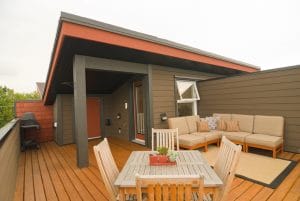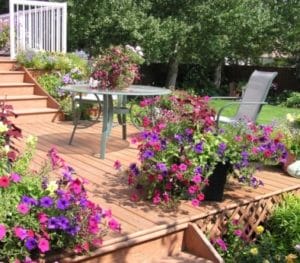Hankering for a handsome back deck? Here’s the low-down on the healthy way to work with woods.
There’s nothing like chilling out in the backyard or enjoying a barbecue on a sunny deck. You want your outdoor spaces to be beautiful, welcoming, serene. However, for people with asthma, allergies and chemical sensitivities, many materials used to make everything from dramatic decks to neighborly fences can put a serious damper on summer fun.
So how can you stop those reactive storm clouds before they roll in?
Blowin’ in the Wind
Most of us understand the need for healthy indoor air quality, especially for people with allergies and asthma. But if you have off-gassing materials outside the home, those fumes will just drift away, right?
Not so fast, says California green architect Eric Corey Freed, founder of organicARCHITECT and bestselling author. He points to the chemicals we find indoors, including formaldehyde and volatile organic compounds (VOCs). These can be found in the engineered woods, stains and other materials we use outside. And Freed says the problem is blowing in the wind.
“Usually we don’t build decks 40 feet away in the backyard; normally they’re attached right to the back wall. It is better that it’s outside and it will off-gas faster in the sunshine, and the wind will carry a lot of it away. But still, it’s right there,” says Freed.
“And usually there are open windows and open doors, so it’s very easy to bring it in.”
Freed says there are a couple of key culprits. One is the older type of chemically treated wood used to make decks, fences and garden borders. That is laden with toxins and requires gloves to handle safely. Another is the formaldehyde that can be found in plywood and engineered woods. The VOCs in exterior paints, stains and sealants can also be a major issue.
“I’ve discovered that a lot of clients are very chemically sensitive to these things and they may not realize the source of it,” says Freed. “So they touch it and it’s absorbed through their skin.”
“Or it off-gasses and they don’t understand why their eyes are watering or their throats are closing up when they’re standing on their decks.”
The Right Stuff
When building decks, fences, sheds, playgrounds and garden beds, it’s important to protect wood from rot and infestation. But it turns out that some garden products have a few dirty secrets of their own.
Widely used to pressure-treat wood since the 1970s, chromated copper arsenate, or CCA, is a toxic mix of chromium, copper and arsenic that is now banned for residential use in most jurisdictions. Of the newer and far safer chemically treated woods on the market, Freed recommends Alkaline Copper Quaternary. Called ACQ wood for short, it also contains the chromium and copper – minus the arsenic.
Even better, he says, is composite lumber, which is made from a mix of sawdust and recycled plastic. Not only are the materials light on the planet because they are readily available – the plastic comes from recycled bags and milk jugs – but the plastic acts as the binding agent. This means that no formaldehyde or other off-gassing glues are required.
“What you have is lumber that is splinter-free, maintenance-free, you don’t need to reseal it every five years, and you could even recycle it when you’re done,” says Freed. The only downside is that the boards get hotter than wood. So they will be toastier on the feet if they’re in the sun. “But it doesn’t off-gas, and you don’t absorb anything through your skin when you touch it, which is what I like about it.”
Also keep in mind that some woods, including western red cedar, redwood and Brazilian walnut known as Ipe (pronounced ee-pay), are naturally durable and resistant to moisture. So they will require less treatment with chemicals, and are great for the outdoors.
Woes with Woods
 Photo: Thinkstock
Photo: Thinkstock While chemicals get most of the blame for reactions, sometimes the compounds that Mother Nature produces can be equally problematic. One of the biggest mistakes that DIY-ers make is putting wood directly into soil. That encourages mold to grow, then spread in the air. “Mold requires two things in order to survive and thrive: One is wetness and the other is some sort of food,” explains Freed. “So if you have a deck that goes directly into the dirt, you’ve essentially stuck a straw into a big pile of food for the mold. So your deck will keep wicking moisture and food and you’ll never get rid of it.”
The key, says Freed, is to keep wood away from soil and other sources of moisture by putting posts into concrete, and by encouraging air flow through the deck so the wood can dry out. He also encourages sweeping decks rather than hosing them down in order to minimize mold growth. “It’s not a garden,” he quips, “it’s a deck.”
But mold isn’t nature’s only backyard troublemaker. For some, certain types of wood, especially in their sawdust form, can trigger asthma, watery eyes and contact dermatitis – even in people who had no idea they were sensitive. According to Dr. Richard Weber, a professor of medicine at National Jewish Health in Colorado, it’s the acids and resins found in woods such as pine, redwood and red cedar that most often cause problems.
“The contact dermatitis is usually due to resins that ooze out of wood that’s not totally cured, and the planks will ooze sap for a while,” says Weber. “The asthma is more likely to happen when you are dealing with fine sawdust that gets up in the air and you inhale it.”
Back Decks and Sawdust
Weber explains that some woods, such as pine, have a coarser sawdust that’s heavier and less likely to get into the lungs. However, harder woods produce finer sawdust that’s easier to inhale. And don’t think you’re off the hook by buying exotic woods from Africa or Asia; there are plenty of reports of those causing reactions as well.
So how can you prevent your deck from taking a bite out of your health? Weber says common sense is key. “People shouldn’t be asking for trouble. If somebody knows they’ve had a problem with a certain type of wood, then they ought to be making the deck out of something else,” he advises. “If someone has reasonably bad asthma to start with, there’s a good chance that inhaling fine dust is going to be irritating no matter what, and then you’ve got to get somebody else to build your deck for you.
“But most of the time it’s a big surprise. People say they never had any trouble and then whammo.”
Determined to do it yourself? Freed says that wearing a mask as well as skin and eye protection is key when working with wood, and it’s wise to close doors and windows to prevent the sawdust from blowing in. Also avoid tracking sawdust inside on your clothes because it will get into your indoor air.
Back Deck Stains, Sealants
 Photo: Getty
Photo: Getty So you’ve built a new deck that will make you the envy of the neighborhood, or you want to breathe new life into that faithful old deck, fence or shed. Problem is, the VOCs and other irritants in exterior stains and sealants frequently spell trouble for people with asthma, allergies and chemical sensitivities.
Fortunately, tighter regulations on VOCs and other chemicals are pushing manufacturers away from asthma-inducing finishes and into healthier water-based compounds, which do a great job of protecting wood while being easier on human health and the environment.
According to Bill Gradisher of PPG Architectural Coatings, makers of some of North America’s biggest stain brands, the industry has been moving in this direction. But especially in the last decade, healthier brands have taken a stronger hold as companies strive to comply with the U.S. Architectural and Industrial Maintenance Coating (or AIM) rules, regional standards – and even stricter measures in the state of California.
“In California they’re aiming for stains that have zero VOC,” says Gradisher. “I think that’s what you’re going to see all manufacturers going with. I don’t see us ever going backwards and saying, ‘Let’s start using a bunch of oils again.’” And while many consumers fear that water-based finishes don’t penetrate as well as oils, so won’t offer adequate wood protection, Gradisher says they can breathe easy on that point.
“Oils do penetrate better, but the drawback to an oil is that it tends to burn out faster from the sun,” explains Gradisher. “The acrylics tend not to penetrate very well. They tend to want to migrate to the surface. But the good thing is they’re a lot more UV-resistant, so they may actually last longer.”
Employing Elbow Grease
Some of Freed’s favorite stain brands include Vermont Natural Coatings, BioShield and Penofin, which all offer eco-friendly options. Another company that has long been ahead of the green curve is Canadian-based stain maker Sansin.
But Freed also encourages his clients to consider natural oils such as ipe oil and linseed oil, which might involve a little more manual labor, but make for a healthier finish.
“You have to oil the wood every season, and that’s work for some people. But hopefully that’s what we evolve to. I think people got tired of doing normal maintenance, so they pursued this dream of a maintenance-free house, and that required heavier and heavier chemistry, where you just have to paint it on once and then only do it every five years,” says Freed.
Over the years, “we painted ourselves into a corner with chemistry to ‘make life easier,’” he notes. “But we sickened ourselves in the process.” So to avoid turning our own backyards into health hazards, Freed says we’d all be better off using a little good ol’ fashioned elbow grease.
Related Reads:
Designer Homes get Allergy-Friendly, Green and Gorgeous
Home Free: Allergy-Proofing the House
Allergic Living’s Go-To Goods for Renovating with Environmental Allergies






